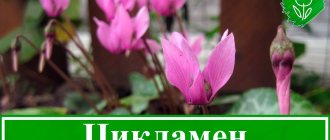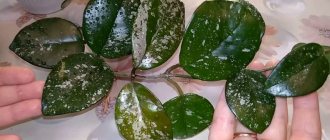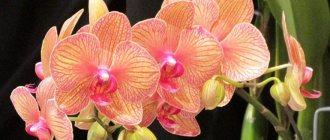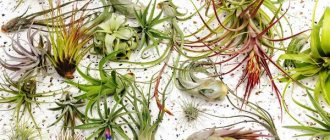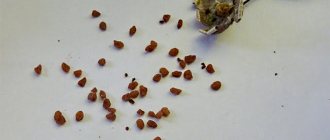Useful tips
Cyclamens are widely known for their attractive heart-shaped flowers and distinct sweet aroma.
The difference between Cyclamen and other house flowers is that they can bloom in winter, giving their owners a great mood in the middle of a harsh and snowy winter.
The magnificent bloom of Cyclamen usually lasts a long time, about several weeks.
Reasons why a transplant is needed
A transplant may be needed in the following cases:
- It is worth replanting a flower if its tuber takes up a lot of space in the pot and the roots have nowhere to grow.
- It is also necessary after purchase, but not immediately, but after several months. The pots in which the flower is sold are too small, so you need to choose a larger container so that the root system can continue to develop unhindered. Read our article about the rules for caring for cyclamen after purchase.
- If a flower was purchased, then you need to know that the land in which it grows is very poor. Immediately after the cyclamen fades, it is replanted. In the case of good soil in a purchased pot, the plant can be left untouched for a whole year.
- Experienced flower growers recommend replanting regularly. This needs to be done once every few years.
Diseases and pests
If you can organize decent care for your flower, then it is unlikely to be attacked by various pests and diseases.
*Abundant application of fertilizers and excessive watering can lead to the appearance of gray rot, which is identified by a gray coating on the leaves. In the future, it may develop into soft and brown areas. If you find on your Cyclamen
similar symptoms, then you should urgently treat it with fungicides and replant it in new soil.
*If at the bottom of the bush you find gray depressed spots that spread throughout the plant with incredible speed, then most likely the plant is affected by rhizoctonia rot.
This disease is usually caused by a constant excess of moisture, due to which a harmful fungus appears in the soil. As soon as you see these signs, stop watering immediately and Cyclamen
, after treating with fungicide, replant.
*If the lower leaves and peduncles of Cyclamen
affected, this is a signal that the plant is suffering from late blight rot. Leaves that slowly begin to dry out usually lead to the complete death of the entire plant. In the early stages, this disease can be treated with drugs: Profit Gol and Previkur.
*Attacks of various pests are found on Cyclamen
not so easy.
To do this, you need to carefully examine the bush for the presence of infected areas. If you notice curled leaves, the appearance of sticky areas and various spots, you should immediately begin treatment with Cyclamen
.
*If, when examining your flower, you find a coating that resembles a layer of dust, this means that the Cyclamen mite
, which, as a rule, lives in colonies on the underside of the leaf.
The appearance of these pests leads to complete curling of the leaves and rapid withering of buds and flowers. To combat this scourge, you will need insecticides, which must be applied only after all infected leaves have been completely removed from the plant.
*Another type of pest is Thrips. These insects usually live off the sap of the plant. They lay their numerous larvae on the underside of leaves. They can also settle directly in the soil and attack the bulb, completely damaging it.
If you notice on Cyclamen
white spots, and the edges of the leaves began to gradually dry out, this is an undoubted sign of a Thrips attack on the plant.
The diseased plant must be thoroughly treated with insecticides, and then sent to quarantine, since this type of insect can fly, and therefore easily move to neighboring plants.
When to perform the procedure?
Important! Transplantation is carried out after the plant comes out of the dormant period, that is, at the end of July or beginning of August. This procedure must be done before the buds appear.
The end of the dormant period can be determined by the formation of young leaves.
The time of transplantation also depends on the type of cyclamen. For example, European cyclamen does not have a pronounced dormant state and remains green all the time. It begins to bloom in mid or late May. If you do a transplant, it will be until then. It is best to carry out the procedure in March.
You should behave completely differently with Persian cyclamen. Every year he experiences a state of rest. It begins in the middle of winter and lasts until the end of summer. In June-August, young leaves begin to hatch, it is during this period that replanting should be done.
General description of cyclamen
Cyclamen is a herbaceous perennial plant. This plant is often grown at home as a decoration. As a rule, the height of cyclamen does not exceed 30 cm.
Depending on the species, the flowering period can be in spring or winter. It blooms with single flowers, which are approximately 8 cm in diameter. They can bloom with regular or double flowers. The color can be red, pink, white, purple depending on the variety.
It has a pleasant, pronounced aroma, which is very widely used in perfumery. According to growth, cyclamen is divided into categories: standard, medium and low growth.
It is worth noting that every year the crown of the plant increases, and the size of the flower decreases.
Photo
Below you can see a photo of the flower:
Can this be done with a flowering plant?
Transplantation at the time of flowering leads to the buds falling off , since the flower experiences stress during the change of soil. This causes flowering and growth to stop. The only exceptions can be those cyclamen that were purchased in a store, and then not immediately, but after the flower gets used to the new place. They need to be replanted from store-bought soil into fresh soil.
Below you can see a photo of the flower:
Preparation for the procedure
Container size
Cyclamen does not do well in large pots. The container is selected taking into account the size of the plant’s rhizome:
- A pot with a diameter of 7-8 centimeters is perfect for a young tuber between one and a half years old.
- Older tubers (2-3 years) need containers with a diameter of 15-16 centimeters.
Reference. The distance from the tuber to the edge of the pot should be 2-3 centimeters.
Priming
A lot depends on the soil, especially the condition of the cyclamen itself, the activity of growth and flowering. Ideally, the soil mixture for cyclamen should be loose and nutritious. Loose soil is the main condition for successful flower growth. Often they buy a ready-made mixture at flower shops. But it's better to do it yourself. For this you will need:
- One part peat.
- Humus is one part.
- Clean sand, also one part.
- Leaf soil - three parts.
In order for roots to form better and the plant to take root better, a little vermiculite is added to the ground. Before planting, the soil must be watered with a weak solution of potassium permanganate. This procedure is necessary to kill fungal pathogens.
Types of cyclamen for the home
- Persian - depending on the variety, it can grow within 15-30 cm. It has large velvety leaves that are pubescent and core-shaped. The flower consists of five petals, the color may vary.
- European - looks very similar to the Persian type of cyclamen, but the leaves are dark green and purple underneath. The European species is much smaller in size than the Persian, the height of the flowers is only 2 cm. This type of plant requires minimal care.
Step by step process instructions
How to transplant homemade cyclamen into another pot - step by step:
Prepare the substrate.- Prepare a new container; if you use an old one, be sure to treat it with potassium permanganate or pour boiling water over it, this is done for disinfection.
- Carefully remove yellowed and dry leaves.
- Carefully remove the plant from the pot and inspect the bulb and roots.
- Dry and rotten roots should be trimmed with clean scissors.
- Since the transplant is carried out into new fresh soil, it is necessary to remove the old soil from the roots as much as possible.
- Next, drainage is poured onto the bottom of the pot and 3-4 centimeters of soil is added.
- Place the flower and add more soil, but do not cover the entire bulb. It should be visible.
- Water the cyclamen thoroughly, but do not get water on the center of the tuber. Drain excess water from the pan.
- Then the flower is put back in place and left alone.
The subtleties of planting in a pot
- It is recommended to replant cyclamens directly with a clod of earth, without disturbing the roots.
- It is useful to pour expanded clay onto the bottom of the pot for drainage, then lay a layer of soil mixture. After this, the tuber is lowered into the pot along with a lump of earth and soil is added so much so that the tuber remains sticking out above the surface of the earth for 13. After planting, the soil is squeezed with your hands.
- 30 days after transplantation, cyclamen requires feeding. Ready-made liquid mixtures are best suited for this.
- During flowering, it is useful to feed cyclamens regularly: once a month (until they bloom).
How to divide a flower correctly?
On a note. Flower division can be done in two ways - tubers and rosettes.
Tubers:
- The first step is to take out the onion and dry it.
- Afterwards, cut into pieces and leave each piece with a bud and a few roots.
- Then we leave it in a dark place to dry the cut.
- When the tuber is planted, the pot is removed away from direct rays.
Sockets:
- To begin with, a shoot is torn off from the tuber and planted in damp soil.
- Next, place the flower under a transparent film.
- After a few weeks, the rosettes will develop roots.
- Be sure to observe the temperature regime.
- Subsequent care is no different from caring for an adult flower.
These and other methods of propagating cyclamen are discussed in more detail in a separate article.
Care
Basic requirements and rules for caring for cyclamen at home:
Lighting and temperature. Cyclamen responds positively to coolness and bright, diffused light. There is no need to place cyclamen under the scorching sun. It will feel best on the western or eastern side. Suitable temperature +10+18 degrees.- Watering. During the growth period, the soil should be sufficiently moistened, but do not overfill the flower with water.
We must rememberthat moist air is beneficial for cyclamen.Immediately after transplantation, there is no need to overwater the flower; you need to do everything as always.
- Feeding is done no earlier than a month after the flower has been transplanted. He needs time to adapt. Moreover, the soil that was prepared for replanting contains humus, which is a natural fertilizer.
What is necessary?
To transplant a purchased plant into another pot, you should prepare everything you need in advance.
- Landing capacity. You can choose a plastic or ceramic pot, as long as it is not too large and has a good drainage hole. Cyclamen loves a tight container, so we choose a new pot 2-4 centimeters larger than the previous one. A new pot must have a tray to collect excess moisture.
- Soil for planting. You can use any soil that is intended for ornamental flowering plants. Cyclamen loves when the soil is loose and rich in organic matter. For the plant, choose slightly acidic soils; the optimal acidity is 5.0-6.5 pH.
- Soil loosening agent. Loosening components must be added to the soil. To do this, you can take vermiculite, coarse river sand, coconut fiber, crushed pine bark.
- Drainage material. Fine expanded clay and gravel are used as drainage.
- Fertilizers. After transplantation, cyclamen does not need to be fertilized for 1-2 months, since it will take microelements useful for it from the soil. After this time, you need to stock up on fertilizer. This can be a liquid fertilizer for ornamental flowering plants of the FORTE brand, the drug “Cyclamen”, “Agricola”.
- Means of protection. Cyclamen is a poisonous plant and precautions must be taken when working with it. To transplant a flower, you will need a pair of rubber gloves.
